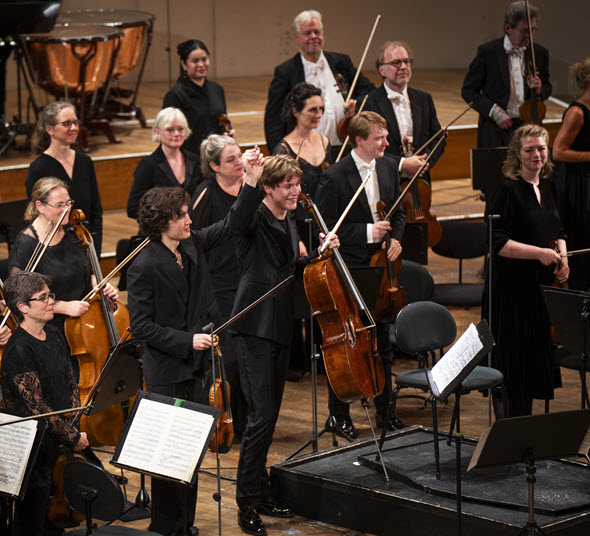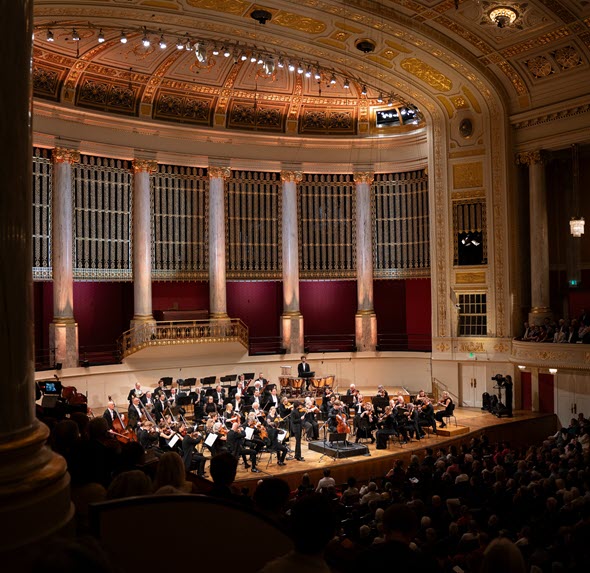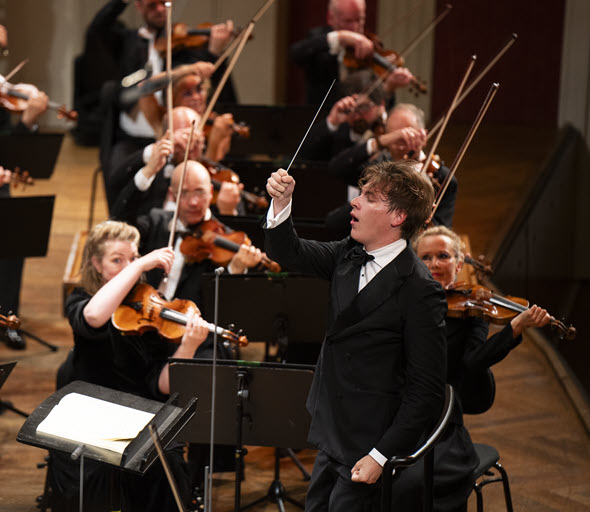Mäkelä, CSO’s maestro-elect, shows his chops with baton and bow in Oslo orchestra concerts

Violinist Daniel Lozakovich and conductor-cellist Klaus Mäkelä take a bow with the Oslo Philharmonic in the Vienna Konzerthaus. (Antonia Wechner photo)
Report: On a Vienna tour stop with his Oslo Philharmonic Orchestra, Klaus Mäkelä played cello in Brahms concerto, led First Symphony.
By Laurence Vittes
VIENNA – It was June 6 and I had come to the Konzerthaus in Vienna to hear Klaus Mäkelä both play cello part and conduct Brahms’ Double Concerto on the Oslo Philharmonic tour fresh from appearances in Amsterdam and Paris. Mäkelä had recently been named music director-designate of the Chicago Symphony Orchestra effective in September 2027 – at the same time he becomes principal conductor of the Royal Concertgebouw Orchestra in Amsterdam.
The programs I heard in Vienna showed that as much as he is a natural in modern music he also has the DNA of Brahms in his blood, perhaps through being a cellist. His performances of the Double Concerto and First Symphony were naturally paced and inclined to the kinds of shaping and surgings that we have come to associate with conductors of eras past, and yet the energy was different: The deep symbolic importance of performances after the war under Wilhelm Furtwängler and other giants proclaiming that the human spirit had survived was replaced by a kaleidoscopic sense of wonder and exploration at what goes on in the music.
Mäkelä, who plays a very sweet-sounding, richly colored Giovanni Tononi instrument made in Bologna around 1695, began the concerto with the impetuous ardor of a young Paul Tortelier – no trudging through the orchestra’s opening bars – and sang out the initial half-note triplets like poetry, with a slightly syncopated phrasing that set the tone and sweep for the music-making to come.
Overall the performance redefined the concerto, Brahms’ last orchestral work, as a collaboration between soloists and orchestra, not between soloists and conductor, and so Mäkelä’s inner cellist was unleashed.
Still to come for Klaus Mäkelä the cellist is Beethoven’s Triple Concerto on July 23 at the Verbier Festival when he will be joined by violinist Leonidas Kavakos and pianist Lahav Shani, with Simon Rattle conducting.
In the Brahms First Symphony and in the program that followed the next night – Weber’s “Oberon” Overture, Sibelius’s “Tapiola” and Zemlinsky’s “Der Jungseefrau” – speeds were measured, never eccentric; instead it was the pulse that gave form and life to the music, Mäkelä’s own body movements giving emphasis. There was something like Leonard Bernstein in the warmth he communicated to the audience. After the outburst of applause for the Brahms pieces, it was even more remarkable to see how the audience responded to Zemlinsky’s sprawling fairytale: the dark outlines, the solo clarinet, the concertmaster’s sweet solos, the rocking of the sea. The listeners demanded six curtain calls.
Mäkelä is a charismatic performer even with his back to the audience. He stands motionless for what seems like eternities, listening to his musicians before flashing out in all directions. The orchestra created the unique Sibelius atmosphere of “Tapiola” and didn’t smooth over the wild fury at the end.

The touring Oslo Philharmonic Orchestra performed with Klaus Mäkelä at the Vienna Konzerthaus. (John-Halvdan Halvorsen photo)
Fans of the orchestras in Amsterdam and Chicago will be encouraged to know that his orchestras in Oslo and Paris have retained their very different sounds and personalities. That both adore him is a mark of how he works: collaboratively and with a level of intuitive conducting genius that the players freely acknowledge. A trombonist in the Vienna Symphony recalled a “stunning Beethoven Ninth” at the Musikverein.
And as I could see during the two concerts and a rehearsal of the Freischütz overture, the musicians take tremendous pride in playing for Mäkelä. Oslo’s principal cello, Louisa Tuck, remembered the first time she worked with Mäkelä: “It was 2019, the Shostakovich Fifth, such a big cello part. I’d seen the videos of his Dvorak cello concerto and I was quite terrified before the start of the symphony! And then he gave the downbeat and I thought, okay, it’s going to be all right.”
Violinist Elise Båtnes, who joined the Oslo Philharmonic at 19, when the still-revered Mariss Jansons was the conductor, compared the two: “Klaus has youth,” she said, “and a craziness to try things, not just doing the proper thing. They have the same energy, the same focus on getting each player to commit and do their best and unite with flexibility in their sound, different qualities and colors. I think any person in the orchestra that did the time with Mariss also feels it’s a little bit the same sort of journey with Klaus. Mariss was more into a system, of course, coming from the Soviet Union and a bit older, but the same spirit of music-making is there.”
Laurence Vittes, a cellist turned critic, has supplied major institutions like the Library of Congress and Harvard University with music collections while introducing prestigious labels to North America like Chandos, Hyperion, Harmonia Mundi and Naxos. His writings for Gramophone, Strings, and other notable publications reflect his belief in unleashing classical music’s potential through journalism.



